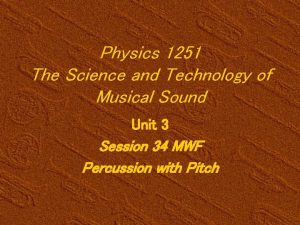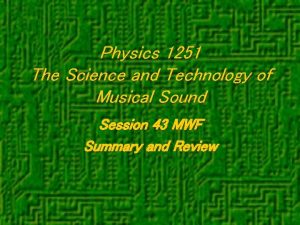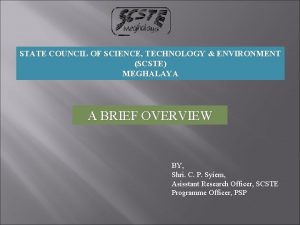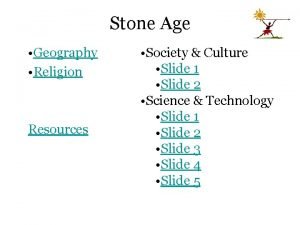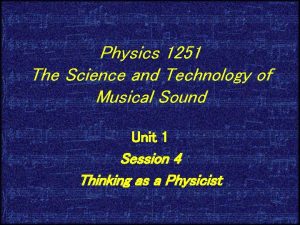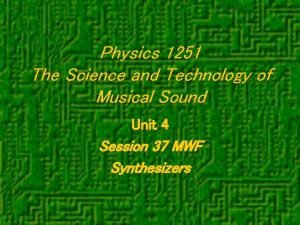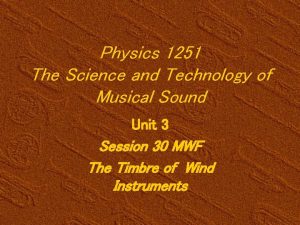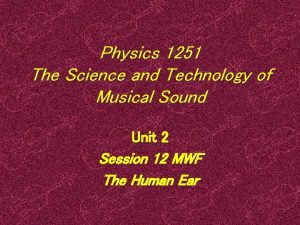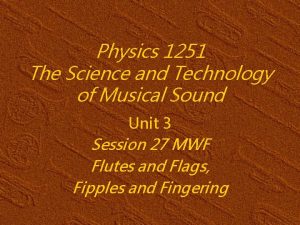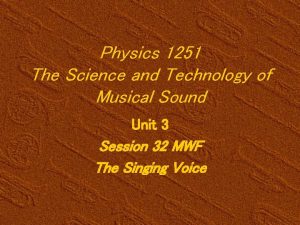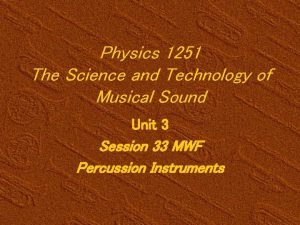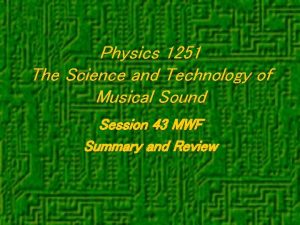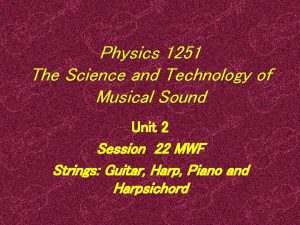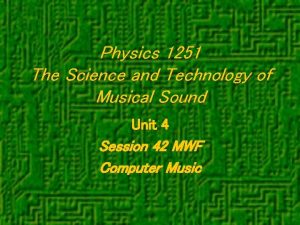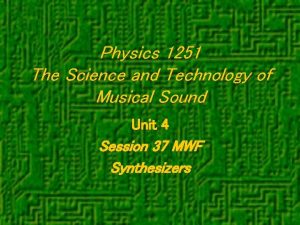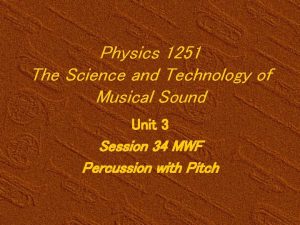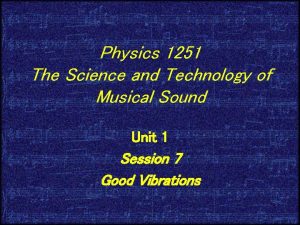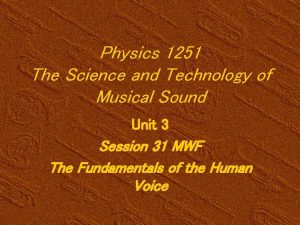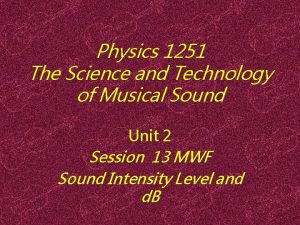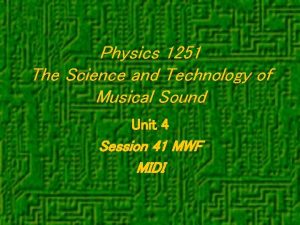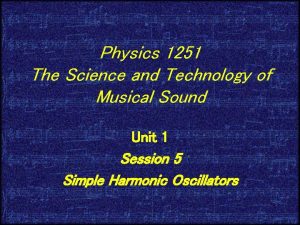Physics 1251 The Science and Technology of Musical




















- Slides: 20

Physics 1251 The Science and Technology of Musical Sound Unit 1 Session 6 Helmholtz Resonators and Vibration Modes

Physics 1251 Unit 1 Session 6 Helmholtz Resonators and Vibration Modes Foolscap Quiz: What is the frequency of a simple harmonic oscillator that has a spring constant of k = 50. 0 N/m and a mass m of 1. 00 kg? Frequency = f = 1/(2π)√(K/m) f = 0. 1592√(50. 0/1. 00) f = 0. 1592√(50. 0) = 1. 13 Hz P =1/f = 1/1. 13 Hz = 0. 89 sec

Physics 1251 Unit 1 Session 6 Helmholtz Resonators and Vibration Modes Put seat number on the Foolscap. Do you wish to sit here “permanently? ” Joe College 1/14/02 Seat #123 Session #1

Physics 1251 Unit 1 Session 6 Helmholtz Resonators and Vibration Modes 1′ Lecture: • • A Helmholtz resonator is a simple harmonic oscillator where the mass is provided by the air in a narrow neck while the spring is provided by a volume of trapped air. The natural frequency of a Helmholtz Resonator is given by the formula: f = [v/(2π)]√[A/ (V L)] A: area of neck v: velocity of sound in air V: volume of Bottle L: length of neck

Physics 1251 Unit 1 Session 6 Helmholtz Resonators and Vibration Modes 1′ Lecture (cont’d. ): • When an object has n masses and n springs, there are n degrees of freedom and n modes of oscillation. Often each mode has a different frequency; occasionally some frequencies are the same.

Physics 1251 Unit 1 Session 6 Helmholtz Resonators and Vibration Modes Does Air have mass and weight? How much? Density = ρ = mass/volume

Physics 1251 Unit 1 Session 6 Helmholtz Resonators and Vibration Modes Density of Air • Density = ρ = Mass/Volume • ρ = 1. 2 kg/ m 3

Physics 1251 Unit 1 Session 6 Helmholtz Resonators and Vibration Modes The “Bulk Modulus” B is the springiness of a gas. B is equal to the change in pressure (in Pa) for a fractional change in volume. B = Δp / (ΔV/V) What is the increase in pressure if I decrease the volume of trapped gas by 50%? B = 1. 41 x 105 Pa. Δp = (ΔV/V) B = 0. 50 (1. 41 x 105 ) = 70 k. Pa.

Physics 1251 Unit 1 Session 6 Helmholtz Resonators and Vibration Modes Air has “Springiness” ΔV V ΔV/V: Force: F = A B ( ΔV/V) = - (A 2 B/V) x 0 0 ΔV 0. 33 20. N 0. 50 30. N

Physics 1251 Unit 1 Session 6 Helmholtz Resonators and Vibration Modes Lowest Frequency Highest Frequency Largest Volume k ∝ 1/V so f ∝ 1/√V Smallest Volume

Physics 1251 Unit 1 Session 6 Helmholtz Resonators and Vibration Modes Turbulence � � � � Simple Harmonic Motion Air “mass” → of Air ↕ Oscillation of air Air “spring” → mass

Physics 1251 Unit 1 Session 6 Helmholtz Resonators and Vibration Modes Two 500 ml Flasks • Same Volume • Same Length of neck • Different diameter ←Smaller Larger → diameter Same frequency? f = 1/(2π)√[k/m] f = 1/(2π)√[(A 2 B/V) / (ALρ)] v= √ B/ρ f = v/(2π)√[A/ (V L)]

Physics 1251 Unit 1 Session 6 Helmholtz Resonators and Vibration Modes Helmholtz Resonator • Ocarina Open holes increase area of “neck. ”

Physics 1251 Unit 1 Session 6 Helmholtz Resonators and Vibration Modes Application of Helmholtz Resonator: Ported Speaker Cabinet Air “Spring” Air “mass”

Physics 1251 Unit 1 Session 6 Helmholtz Resonators and Vibration Modes Normal or Natural Modes of Oscillation

Physics 1251 Unit 1 Session 6 Helmholtz Resonators and Vibration Modes Two Masses on Two Coupled Springs Spring ———→ Mass ————→ Spring ————→ Mass ————→ Mode 1 Mode 2

Physics 1251 Unit 1 Session 6 Helmholtz Resonators and Vibration Modes 80/20 A Simple Harmonic Oscillator has only one Normal or Natural Mode of Oscillation and only one frequency of oscillation.

Physics 1251 Unit 1 Session 6 Helmholtz Resonators and Vibration Modes 80/20 The number of Normal or Natural Modes of Oscillation is equal to the number of simple harmonic oscillators that are coupled together.

Physics 1251 Unit 1 Session 6 Helmholtz Resonators and Vibration Modes 80/20 Two Normal or Natural Modes of Oscillation are called “degenerate” if they have the same frequency.

Physics 1251 Unit 1 Session 6 Helmholtz Resonators and Vibration Mode Summary: • A Helmholtz Oscillator is a SHO comprised of an enclosed air volume and a narrow neck and has a single frequency. • A normal or natural mode of vibration or oscillation is one of the fundamental ways that a device can move. • The number of modes is equal to the number of simple harmonic oscillators in the system. • Degeneracy means two or more normal modes have the same frequency.
 Physics 1251
Physics 1251 Physics 1251
Physics 1251 Sciencefusion think central
Sciencefusion think central Her favourite subject is english
Her favourite subject is english Why does it happen
Why does it happen University physics with modern physics fifteenth edition
University physics with modern physics fifteenth edition Physics ia
Physics ia Hanoi university of science and technology vietnam
Hanoi university of science and technology vietnam Ulsan national institute of science and technology
Ulsan national institute of science and technology Scste
Scste Science and technology center ukraine
Science and technology center ukraine Science technology university yemen
Science technology university yemen Masdar institute of science and technology
Masdar institute of science and technology Madhav institute of technology and science
Madhav institute of technology and science Jordan university of science and technology
Jordan university of science and technology Jordan university of science and technology
Jordan university of science and technology Grade 4 natural science term 2 test
Grade 4 natural science term 2 test Nature of science technology and society
Nature of science technology and society Adverb form of technology
Adverb form of technology Stone age science and technology
Stone age science and technology Tufts science and technology center
Tufts science and technology center
